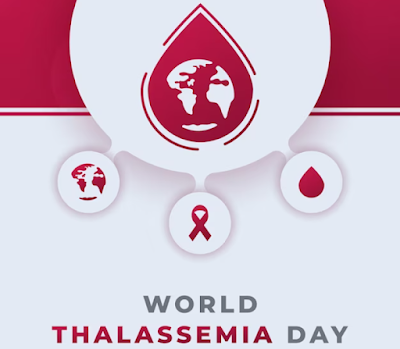Understanding Thalassemia: Types, Causes, Symptoms, Treatment, and Management"
Thalassemia:
Thalassemia is a genetic blood disorder that affects the production of hemoglobin, the protein in red blood cells that carries oxygen supply throughout the body.
There are two main types of thalassemia: Alpha thalassemia and Beta thalassemia.
Types of Thalassemia
Alpha thalassemia:
This type of thalassemia occurs when there is a deficiency in one or more of the four alpha globin genes. This can lead to a range of symptoms, from mild to severe.
Beta thalassemia:
This type of thalassemia occurs when there is a deficiency in the beta globin gene. This can lead to a range of symptoms, from mild to severe.
Causes of Thalassemia
Thalassemia is a genetic disorder that is inherited from a person's parents. It is caused by mutations in the genes that produce hemoglobin. A person must inherit two copies of the abnormal gene, one from each parent, in order to develop the disease.
Signs and Symptoms of Thalassemia
- Fatigue
- Weakness
- Pallor
- Slow growth
- Abdominal swelling
- Bone deformities
- Jaundice
- Anemia
Treatment and Management of Thalassemia
Blood transfusions:
This is the most common treatment for thalassemia. A person with the disorder may need to receive blood transfusions every few weeks to help keep their hemoglobin levels normal.
Iron chelation therapy:
People with thalassemia often have too much iron in their bodies because of the repeated blood transfusions. Iron chelation therapy is used to remove the excess iron.
Bone marrow transplant:
A bone marrow transplant can cure thalassemia. But the procedure is complex, and there are many risks involved.
Prevalence of Thalassemia
Thalassemia is a common genetic disorder worldwide. It is most prevalent in people of Mediterranean, African, and Southeast Asian descent.
Alpha Thalassemia
Alpha thalassemia is caused by a mutation in the genes that produce alpha globin, a component of hemoglobin. It can be classified into four types:
Alpha thalassemia minor:
Two of the four alpha globin genes are affected, and it usually causes no symptoms.
Alpha thalassemia trait:
Three of the four alpha globin genes are affected and it cause mild anemia.
Hemoglobin H disease:
three alpha globin genes are affected and it causes moderate to severe anemia.
Alpha thalassemia major:
All four alpha globin genes are affected, and it causes severe anemia that usually requires frequent blood transfusions.
Beta Thalassemia
Beta thalassemia is caused by a mutation in the beta globin gene. It can be classified into two types:
Beta thalassemia minor (also called thalassemia trait): One of the two beta globin genes is affected, and it usually causes no symptoms.
Beta thalassemia major (also called Cooley's anemia): Both of the beta globin genes are affected, and it causes severe anemia that requires frequent blood transfusions.
Conclusion
Thalassemia is a genetic blood disorder that affects the production of hemoglobin. It is caused by mutations in the genes that produce hemoglobin. There are two main types of thalassemia: alpha thalassemia and beta thalassemia. Symptoms of thalassemia include fatigue, weakness, lethargic and shortness of breath.












